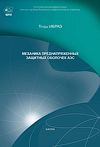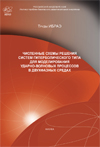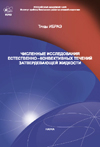| Русский / English |
|

|
NUCLEAR SAFETY INSTITUTE OF THE
RUSSIAN ACADEMY OF SCIENCES
|
SCIENTIFIC PAPERS
 | Proceedings of IBRAE RAS Issue 6: Mechanics of prestressed concrete containment for NPP Ed. by L. А. Bolshov, R. V. Arutyunyan In the collection of papers the materials based on the experimental, real and calculation data obtained by authors in course of research into the stress strain state of the containment are presented. In the papers the results of analysis of operational abilities under different normal and accident situations are considered and discussed. Important scientific and practical conclusions are made for improvement of NPP operation safety. The volume is intended for research and design organizations specialists, for universities lecturers, and engineers of fuel and power industry. It can be used as a textbook for undergraduate and postgraduate students of civil engineering institutes. Bibliographical reference Proceedings of IBRAE RAS / Ed. by L. А. Bolshov ; Nuclear Safety Institute (IBRAE) RAS. — Moscow : Nauka, 2007— . Issue 6 : Mechanics of prestressed concrete containment for NPP / Ed. by R. V. Arutyunyan. — 2008. — 151 p. : ill. — ISBN 978-5-02-087031-9 (bound). |
 | Proceedings of IBRAE RAS, Issue 5: Models for Fission Products Release from Irradiated UO2 Fuel Ed. by L.A. Bolshov, R.V. Arutyunyan The main models of the mechanistic code MFPR are described. Exhaustive description of fissiongas behaviour in grain and out of grain is given in relation with individual validation results on analytical experiments under various conditions (steady irradiation, transient, post-irradiation annealing). The mechanistic description of chemicallyactive-elements behaviour is also presented. It is based on complex association of diffusionvaporization The assumed target for the issue are students and specialists in nuclear materials research and NPP safety analysis. Bibliographical reference Nuclear Safety Institute (IBRAE) RAS. — Moscow: Nauka, 2007— .Issue 5 : Models for Fission Products Release from Irradiated UO2 Fuel / Ed. by R.V. Arutyunyan. — 2008. — 157 p. : ill. — ISBN 978-5-02-036951-1 (bound). |
 | Proceedings of IBRAE RAS, Issue 4: Numerical methods to simulate shock wave processes in the two-phase mixtures Ed. by L. A. Bolshov, V. M. Goloviznin The possibility of using the Piecewise-Parabolic-approximation Method (PPM) to solve the advection equation and hyperbolic-like systems is considered. New approaches to simulation of shockwave processes in two-phase media are described, namely, the application of non-linear difference schemes with correction of flows to calculations of two-phase compressible gas-dynamic flows. The possibility of simulation using the PPM and the exact Riemann solver of two-component and twophase compressible media, taking also into account the micro-inertia phenomenon, is discussed.
Bibliographical reference Nuclear Safety Institute (IBRAE) RAS. — Moscow :Nauka, 2007— . Issue 4 : Numerical methods to simulate shock wave processes in the two-phase mixtures / Ed. by V. M. Goloviznin. — 2008. — 119 p. : ill. — ISBN 978-5-02-036950-4 (bound).
|
![Proceedings of IBRAE RAS Issue 3: Methods of computational hydrodynamics for the for the safety analysis of TEK’s objects [in Russian]](/pictures/109/pic1_11022014162859.jpg) | Proceedings of IBRAE RAS Issue 3: Methods of computational hydrodynamics for the for the safety analysis of TEK’s objects [in Russian] Ed. by L.A. Bolshov
Bibliographical reference Methods of computational hydrodynamics for the for the safety analysis of TEK’s objects [in Russian] : Proceedings of Nuclear Safety Institute RAS (IBRAE RAS) / Ed. by corresponding member of RAS L. A. Bolshov. — Iss. 3. — Moscow : Nauka, 2008. — 207 p. : ill. |
 | Proceedings of IBRAE RAS Issue 2: Numerical Investigations of Naturally-convective Flows in Solidifying Liquid Ed. by L.A. Bolshov, V.F. Strizhov In the course of performed investigations several important outcomes were achieved and a series of interesting mechanisms were identified that may be of use while developing simplified codes for analysis of individual severe-accident phases for cases of retention of molten fuel-containing masses inside the vessel. The first section describes numerical methods for solution of 2D hydrodynamics problems for solidifying liquid, the second section provides the results of parametric numerical investigation of main heat- and masstransfer mechanisms of heat-generating liquid for the case of melt retention by reactor vessel. The attention is focused on studying major heat- and mass-transfer mechanisms of heat-generating liquid taking account of phase transitions through the application of a computational algorithm based on the fictitious-area method under “flow function, vorticity” variables. Effectiveness of calculations, being an advantage of the approach used, enables application of a unified computational algorithm within arbitrary areas for the category of problems under consideration. Owing to its originality and efficiency, the offered approach may be recommended to specialists of nuclear-power industry and adjacent areas. Bibliographical reference Numerical Investigations of Naturally-convective Flows in Solidifying Liquid / Edited by Professor V. F. Strizhov // Proceedings of Nuclear Safety Institute RAS (IBRAE RAS) / Edited by corresponding member of RAS L. A. Bolshov. — Issue 2. — Moscow: Nauka, 2007. — 190 p.: illustrations. |
 | Proceedings of IBRAE RAS Issue 1: Models for the Fuel Rod Materials Interactions during Reactor Core Degradation under Sever Accident Conditions at NPP (in English) Ed. by L.A. Bolshov A set of mechanistic models for the main degradation phenomena: cladding oxidation, hydrogen absorption and mechanical deformation, UO2 and ZrO2 dissolution by molten Zr, was developed in the Nuclear Safety Institute (IBRAE) RAS and combined in the code package SVECHA. In order to be applied to mechanistic modeling of various single-rod degradation experiments (including the FZK QUENCH tests), the models were tightly coupled in the advanced mechanistic code SVECHA/QUENCH. The models were also implemented in various system-level SA codes: ICARE2 (IRSN, France), SCDAP/RELAP5 (NRC, USA), the Russian SA codes RATEG/SVECHA and SOCRAT. The book presents the main models of the code package SVECHA and the single-rod code SVECHA/QUENCH. Bibliographical reference Models for the Fuel Rod Materials Interactions during Reactor Core Degradation under Sever Accident Conditions at NPP (in English). Edited by Professor V.F. Strizhov. — Proceedings of Nuclear Safety Institute RAS (IBRAE RAS). Edited by corresponding member of RAS L.A. Bolshov. Issue 1. — Moscow: Nauka, 2007. — 127 p.: illustrations.
|
| Investigation of the channels of excitation and decay of the anomalously low-energy isomeric level 3/2+ (3.5±1.0 eV) in the Th-229 nucleus International Investigation Project, approved by INTAS-RFBR in 1995 (reference number 95-IN-RU-828)
Project Coordinator: Romain Coussement, Professor, Director of Instituut voor Kern-en Strahlingsfysika, Katholieke Universiteit Leuven Russian Principle Investigator: Tkalya Eugenii Viktorovich, Doctor of physical and mathematical sciences, Head of laboratory, Nuclear Safety Institute of RAS | |
 |
IBRAE RAN © 2013-2024 | Site map | Feedback |